
Am Fam Physician. 2007;75(3):342-348
A more recent article on braces and splints for common musculoskeletal conditions is available.
Author disclosure: Nothing to disclose.
Braces and splints can be useful for acute injuries, chronic conditions, and the prevention of injury. There is good evidence to support the use of some braces and splints; others are used because of subjective reports from patients, relatively low cost, and few adverse effects, despite limited data on their effectiveness. The unloader (valgus) knee brace is recommended for pain reduction in patients with osteoarthritis of the medial compartment of the knee. Use of the patellar brace for patellofemoral pain syndrome is neither recommended nor discouraged because good evidence for its effectiveness is lacking. A knee immobilizer may be used for a limited number of acute traumatic knee injuries. Functional ankle braces are recommended rather than immobilization for the treatment of acute ankle sprains, and semirigid ankle braces decrease the risk of future ankle sprains in patients with a history of ankle sprain. A neutral wrist splint worn full-time improves symptoms of carpal tunnel syndrome. Close follow-up after bracing or splinting is essential to ensure proper fit and use. Am Fam Physician 2007;75:342–8. Copyright © 2007 American Academy of Family Physicians.)
Family physicians often must make decisions regarding the use of braces or splints in the management of musculoskeletal disorders. Bracing can be useful for acute injuries, and also for chronic conditions and in the prevention of injury. The purpose of braces and splints is to improve physical function, slow disease progression, and diminish pain. They can be used to immobilize an unstable joint or fracture, to unload a portion of a joint and improve pain and function, to eliminate range of motion in one direction, or to modify range of motion in one or more directions. They do not replace a good rehabilitative program, and the entire spectrum of treatment options should be explored and used as needed.
| Clinical recommendation | Evidence rating | References |
|---|---|---|
| Unloader (valgus) braces are recommended to reduce pain and improve function in patients with varus (medial compartment) osteoarthritis of the knee. | B | 6 |
| There is insufficient evidence to support or discourage the use of patellar bracing for patellofemoral pain syndrome. | B | 7,8 |
| Functional treatment of acute ankle sprains with semirigid or soft, lace-up braces is recommended over immobilization. | A | 21 |
| A semirigid ankle brace worn during performance of high-risk sports such as soccer or basketball is an option to reduce the risk of future ankle sprains for patients with a history of ankle sprains. | A | 22 |
| A neutral wrist splint improves symptoms of and function with carpal tunnel syndrome when used for at least four weeks. | B | 25 |
| Wrist splints for carpal tunnel syndrome are most effective when they are worn full-time. | B | 28 |
Accurate diagnosis of the injury is important in determining whether a brace or splint is indicated. Generally, splints are for short-term use. Excessive, continuous use of a brace or splint can lead to chronic pain and stiffness of a joint or to muscle weakness. However, long-term use of some braces, such as a knee unloader brace, can help prevent progression of pain attributable to osteoarthritis of the knee.
Given the limited evidence on the use of braces and splints, it is particularly important to use a patient-centered approach, with consideration for individual patient's expectations and concerns and an understanding of the nature of their activity. For example, for high school and collegiate athletes, there are specific rules on the types of protective equipment, splints, and braces that may be worn during competition.1 Close follow-up after bracing or splinting is essential to ensure proper fit and use.
The most common types of braces and splints used in primary care and the quality of evidence to support current recommendations are discussed in the following. Braces and splints recommended for common musculoskeletal conditions are listed in Table 1.
| Musculoskeletal condition | Recommended brace or splint |
|---|---|
| Medial compartment osteoarthritis of the knee | Unloader (valgus) knee brace |
| Anterior knee pain (patellofemoral pain syndrome) | Mixed results: consider no brace or knee sleeve with buttress |
| Acute knee injury (e.g., tendon or ligament rupture or fracture) | Knee immobilizer |
| Acute ankle sprain | Semirigid stirrup brace (e.g., Aircast) or soft, lace-up brace |
| Prevention of recurrent ankle sprain | Semirigid stirrup brace (e.g., Aircast) |
| Carpal tunnel syndrome | Neutral wrist splint |
Knee Braces
Knee braces have been developed to unload the medial compartment for patients with varus osteoarthritis, to treat anterior knee pain, and to immobilize the knee.
UNLOADER (VALGUS) KNEE BRACE
Unloader, or valgus, knee braces have been proposed as one treatment option for patients with medial compartment osteoarthritis of the knee. These braces are designed to apply an external valgus force, thereby reducing the load on the medial compartment and decreasing related pain (Figure 1). Improved joint proprioception also may play a role in reducing pain.2,3 Indications for this type of brace include radiographic evidence of unicompartmental osteoarthritis (medial compartment) and varus malalignment.
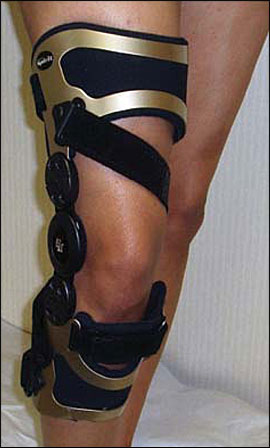
Relatively few studies on bracing have been published, and most are not randomized controlled trials. A Cochrane systematic review4 identified only one randomized controlled trial.2 In this study, 119 patients who had osteoarthritis associated with varus deformity of the knee were randomized to receive usual treatment, unloader knee brace, or neoprene sleeve to evaluate the effect of these therapies on functional status and quality of life.2 Although both the sleeve and the brace reduced pain and improved function, greater benefit was found with the unloader brace. In a randomized crossover trial, 12 patients with varus osteoarthritis were given a simple hinged brace or an unloader brace during two six-month periods. Because patients acted as their own controls, it was possible to identify statistically and clinically significant benefits for the unloader brace that were greater than those of the hinged brace despite the small number of patients involved in the study.5 The American Academy of Orthopaedic Surgeons recommends unloader braces for the reduction of pain in patients with osteoarthritis of the knee.6 This conservative option is thought to extend the time before patients need to undergo knee arthroplasty; it also can be considered for those who are not candidates for surgery.
ANTERIOR KNEE PAIN BRACE
Anterior knee pain, also called patellofemoral pain syndrome (PFPS), is a common complaint among young, active patients. Its etiology is multifactorial and controversial, and the treatment can be frustrating for the physician and the patient. Braces have been developed to address the most commonly accepted etiology: malalignment of the patellofemoral joint. Typically, these braces are made of neoprene or a similar elastic material, with additional straps or a buttress for patellar support. The buttress can be circular, C-shaped, J-shaped, or H-shaped to help maintain tracking of the patella in the femoral groove. These braces are reasonably priced, and off-the-shelf models are adequate (Figure 2).
Evidence of the effectiveness of braces for treatment or prevention of PFPS is limited because of methodologic differences and shortcomings across studies. Two systematic reviews published in 2002 and 2003 concluded that, because of the low quality of available studies, there is insufficient evidence to support or to discourage the use of patellar bracing for PFPS.7,8 Likewise, an American Academy of Pediatricians technical report stated that there is no scientific evidence to support the use of knee sleeves.9
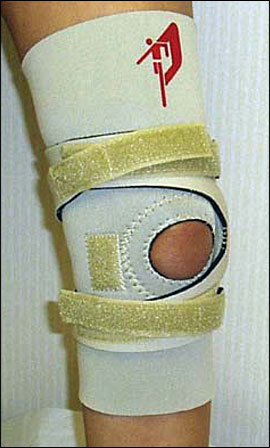
Two studies, published after the systematic reviews, produced contradictory results.10,11 In one small, anatomic study using magnetic resonance imaging, researchers examined patellar alignment, patellofemoral joint contact area, and pain response in patients with and those without bracing.10 They found significant changes in contact area and improvement in pain in the braced group but little change in patellar alignment. In a prospective randomized clinical trial published in 2005, researchers randomized 136 patients with anterior knee pain to treatment with home exercises, patellar bracing, exercises plus bracing, or exercises plus knee sleeve, and found no difference in pain ratings between the four groups after 12 weeks.11 Small studies on military recruits have reported a decrease in the incidence of anterior knee pain with patellar bracing.12,13
Because of the limited data and lack of clear recommendations and consensus on the effectiveness of patellar braces for the treatment or prevention of anterior knee pain, decisions regarding their use must be made on an individual basis. Some patients may feel benefits; therefore, patients should be told that study results are inconclusive or mixed. A therapeutic trial of braces may be worthwhile because the braces are not expensive and no harmful effects have been found. Nonetheless, a brace is no substitute for a good rehabilitative program that includes strengthening, range-of-motion, and proprioceptive exercises.14–17
KNEE IMMOBILIZER
Complete immobilization of the knee for an extended period is generally contraindicated because of the prolonged stiffness, muscle atrophy, and chronic pain that result. However, there are exceptions. Indications for the use of a knee immobilizer (Figure 3) include the acute (or presurgical) management of quadriceps rupture, patellar tendon rupture, medial collateral ligament rupture, patellar fracture or dislocation, and a limited number of other acute traumatic knee injuries. The duration of immobilization and management of these conditions is variable and beyond the scope of this article.
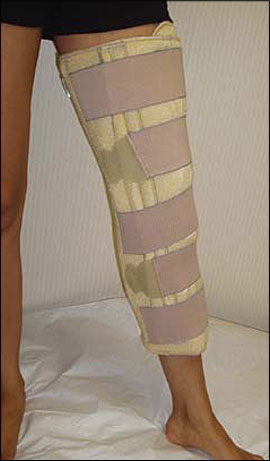
OTHER KNEE BRACES
Other knee braces include prophylactic braces designed to prevent or limit the severity of knee injuries. These braces are used commonly by football players to help protect against medial collateral ligament injury. Functional knee braces are designed to provide stability to a ligament-deficient knee (e.g., in a patient with an anterior cruciate ligament tear before surgery) and also can be used for postsurgical repair. Rehabilitative knee braces are used postoperatively to allow protected range of motion.6 Recommendations for the proper selection and use of these braces are highly variable, complex, and often inconsistent; the choice seems to be based on anecdotal experience and trial and error.
Ankle Braces
Ankle sprains are one of the most common acute musculoskeletal injuries. The treatment of lateral ankle sprains can be confusing because of the many braces and splints that are available for this injury. Ankle braces can be divided into two categories: rigid and functional. Rigid braces essentially immobilize the entire ankle. Functional braces, which include semirigid (e.g., Aircast) and soft, lace-up braces, allow some plantar and dorsiflexion at the ankle while controlling for inversion and eversion. Semirigid braces are made of thermoplastic contoured lateral stirrups lined with air-filled foam pads for support of the medial and lateral malleoli. Supplemental air can be added to these air cells through an inlet port.18 Soft, lace-up braces are usually made of canvas. Semirigid stirrup braces restrict ankle inversion and eversion more than lace-up braces19 (Figures 4 and 5). External ankle support also has been shown to improve proprioception, an important component in the reduction of recurrent ankle sprains.19
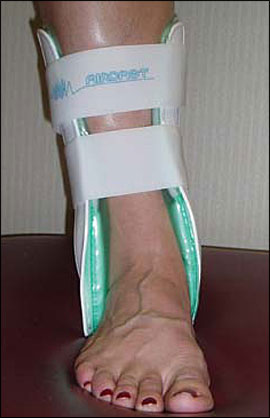
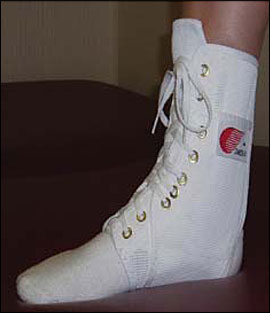
FUNCTIONAL ANKLE BRACES
Complete immobilization of the ankle following an acute ankle sprain is no longer recommended. Early mobilization using functional treatment is preferred.20 A Cochrane systematic review concluded that treatment of acute ankle sprains with functional braces leads to better outcomes (e.g., shorter time taken to return to work or sport, less swelling and instability, greater overall satisfaction) compared with immobilization.21
A systematic review identified nine randomized trials that compared different functional treatment strategies (e.g., lace-up or semirigid brace, elastic bandage) for acute lateral ankle ligament injuries.20 Because of the variety of treatments and inconsistently reported follow-up times, the most effective functional treatment brace could not be identified. However, lace-up ankle braces more effectively reduced short-term swelling than did semirigid ankle braces. The most recent randomized controlled study, published in 2005, demonstrated improvement in ankle joint function after a moderate to severe inversion injury using a semirigid (Aircast) brace.18 Thus, the evidence supports a functional treatment approach to inversion ankle sprains with the use of a semirigid or soft, lace-up brace.
PROPHYLACTIC ANKLE BRACES
Multiple studies have evaluated the effectiveness of ankle braces for the prevention of ankle sprains. There is good evidence that semirigid braces help to prevent ankle sprains during high-risk sports such as soccer and basketball. According to a Cochrane systematic review, patients with a history of ankle sprain can be advised that wearing such a brace reduces their risk of future ankle sprains.22
Few studies recommend the duration for which ankle braces should be used. However, one systematic review on the prevention of ankle sprains in sports recommends that patients who sustain moderate or severe ankle sprains should wear an ankle brace during sports activity for at least six months following the injury.23
Wrist splints
Carpal tunnel syndrome is a common compression neuropathy, often treated initially with a splint to relieve pressure on the median nerve. Few recent studies have addressed the effectiveness of wrist splints in the treatment of carpal tunnel syndrome, and no randomized controlled trials have compared wrist splinting with no treatment. One systematic review concluded that there is limited evidence to support the use of splinting for up to six months,24 whereas a second review found that a hand brace improved symptoms and function after four weeks.25
There are various options when prescribing a wrist splint, including neutral versus cock-up (extension) splints, nighttime versus full-time wear, duration of wear, and custom versus prefabricated splints. One prospective study found that neutral splints relieved symptoms more than cock-up splints (20 degrees of extension).26 The authors also found that symptom relief was evident in the first two weeks of wearing the splint; no additional improvement was noted between weeks 2 and 8 of wear.26 The first long-term prospective randomized study to compare nighttime splint wear with steroid injection found improvements in symptoms as well as motor and sensory nerve conduction velocities after one year of wearing a splint at night.27 Another randomized clinical trial, comparing symptoms and functional deficits in nighttime versus full-time splint wear, found the most significant improvements at six-week follow-up in the group instructed to wear the splints full-time.28
Splints come with a dorsal or volar compartment in which metal or thermoplastic inserts can be placed. It is easier to mold a custom insert than it is to mold a prefabricated metal one29 (Figure 6). When fitting a prefabricated wrist splint, it is important to observe the wrist position, because off-the-shelf wrist splints may have significant extension. Prefabricated splints, which tend to be more rigid and less comfortable than thermoplastic custom splints, typically are made to have 10 to 30 degrees of extension. Patients wearing prefabricated splints should return with the splint so that the angle can be adjusted to the neutral position if necessary. Researchers suggest that prefabricated splints must be adjusted to the neutral position in patients with carpal tunnel syndrome.28
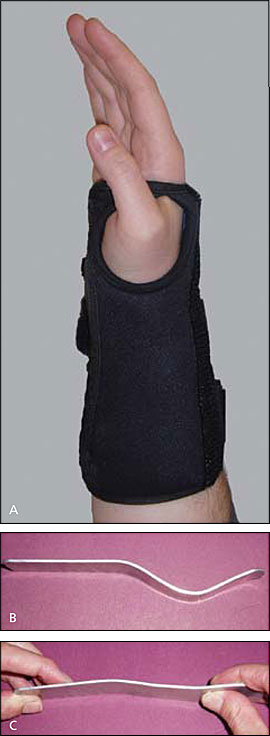
Thus, the evidence suggests that patients with carpal tunnel syndrome who choose to use a wrist splint should wear a neutral-position splint full-time for at least four weeks.